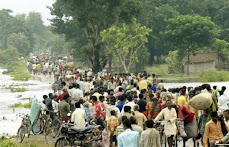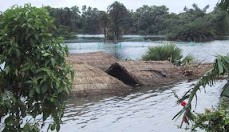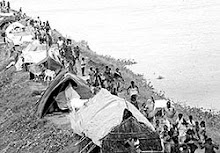Historically, floods and their control have never been a big issue in the Ganga-Brahmaputra basin, as it is today. Floods became a major issue after the British occupied India. When they examined the Ganga basin, they believed that if it could be made “flood-free”, they could levy a tax in return for such protection.
Tuesday, 23 September 2008
The Worst Is Yet To Come
Why, after 60 years of band-aid remedies for the Kosi, is there no lasting
solution yet, asks GOPAL KRISHNA
ON AUGUST 19, 2008, the chairman of the Expert Committee on the Implementation
of recommendations of Rashtriya Barh Ayog, R Rangachari said, “It is my
impression that not much has been done to implement the suggestions made by the
committee’s report.” Rangachari was on the Prime Minister’s Task Force on Flood
Control in 2004.
The National Common Minimum Programme (CMP) of the Government of India made a
solemn pledge to the people of the country in 2004 to undertake “Long-pending
schemes in specific states that have national significance, like flood control
and drainage in North Bihar.” Despite acknowledging the problem, it is shocking
that neither the Central nor Bihar Government conducts any survey to assess the
effect of flood control measures on the socio-economic conditions of society.
On August 20, 2008, after the breach in the embankment at Kusaha in the Kosi
region, Nepalese Prime Minister Pushpa Kamal Dahal `Prachanda’, took stock of
the post-calamity situation in the Kosi region and said “Kosi agreement was a
historic blunder. The people are suffering due to this”. The agreement had led
to the construction of embankments and proposals for a high dam.
Following an aerial survey of the flood affected areas of Bihar, the Indian
Prime Minister on August 28, 2008, termed the flood crisis as “a national
calamity”. More than four years have passed since the Indian Prime Minister made
the promise in the CMP. Now, in August 2008 he declared, “A high-level team
would be set up to coordinate matters with the Government of Nepal.” He also
promised protective structures and technical assistance to state government to
prevent further deterioration in the embankments. Such dangling of carrots and
providing band-aid remedies are horribly insincere and it has been going on for
over 60 years.
Bihar’s floods in August 2008 caused the eighth breach in the embankments.
According to the Bihar Government’s own reports, last year 48 lakh people in 22
districts were in need of assistance due to floods. Clearly, it is not the
extent, but the unpredictable intensity of the crisis that makes it a
catastrophe. The primary function of floodwater is to drain out excess water. It
has not been allowed to perform its functions due to engineering interventions.
Hundreds of reports prepared by Commissions of all ilks are gathering dust. At
most, they become election campaign tools. The Commission should recommend
fixing charges of criminal neglect against the members of the Kosi High-Level
Committee, who waited for the calamity despite having information that could
have led to timely evacuation of the people.
The drainage problem has failed to alter the policy regime of the country that
favours structural solutions regardless of the natural drainage it may impede.
Proposals like a high dam on the Kosi are as good as jumping from the frying pan
into the fire, if the experience with embankments is anything to go by. Even
when one chooses to ignore the changing morphology of the river, the estimated
lifespan of a dam and embankment being 25 and 37 years respectively, underlines
the transitory nature of the technocentric interventions. The Union Ministry of
Water Resources misled the Rajya Sabha on March 11, 2008 claiming, “Government
has taken various steps in the direction of water management to stop the flood
in north Bihar coming from the rivers of Nepal.” There has been no significant
shift in the way the Kosi issue was perceived in the 1950s and in 2008.
The issue of the Kosi High Dam, first raised in 1948, has been sold to the
victims as one of the ‘permanent’ solutions to recurring floods. Ironically,
embankments as temporary solutions have become reasonably permanent whereas the
‘permanent’ solution has remained elusive. What is ‘permanent’ and how permanent
is ‘permanence’? It must be acknowledged now that there is a condemnable
insincerity in proposing multi-purpose high dams for flood control, because the
dams are proposed to tap the hydropower potential. Is it not clear that when the
multipurpose — flood control, irrigation and power — dam is talked about, the
real motive of the proposal in question is ignored? Clearly, political parties
hold a stake in such power projects that make them little concernend with the
masses struggling to remain afloat. A few days ago, Nepalese Prime Minister,
Prachanda, conveyed his affirmation for the hydel power project in a meeting
with Bihar Chief Minister Nitish Kumar at a lunch hosted by JD(U) leader Sharad
Yadav.
THERE IS a compelling logic behind seeking immediate review of the Indo- Nepal
Kosi Treaty that created the rationale for embankments and dams. Continuing with
it would amount to flogging a dead horse. The congestion in North Bihar and
Nepal is a problem of permanent water-logging that has remained overlooked for
several decades. Floods, earthquakes, hurricanes or tsunamis cannot be
controlled. But the catastrophe they cause can be predicted, anticipated and
prevented. Drainage of the river must remain sacrosanct, besides timely
evacuation of human and animal population and the establishment of robust public
health systems.
Given its distinct geo-morphological features and complicated hydrological
characters, the Kosi is one of the Himalayan rivers that has yet to be
understood in its entirety. It is high time that policy makers gave up their
outdated ‘conquest over nature’ paradigm. We have to learn to live with the
floods, only this time, in far more readiness.
(Gopal Krishna is a member of the fact finding misson on the Kosi in Bihar and
Nepal)
From Tehelka Magazine, Vol 5, Issue 38, Dated Sept 27, 2008
Subscribe to:
Post Comments (Atom)








No comments:
Post a Comment